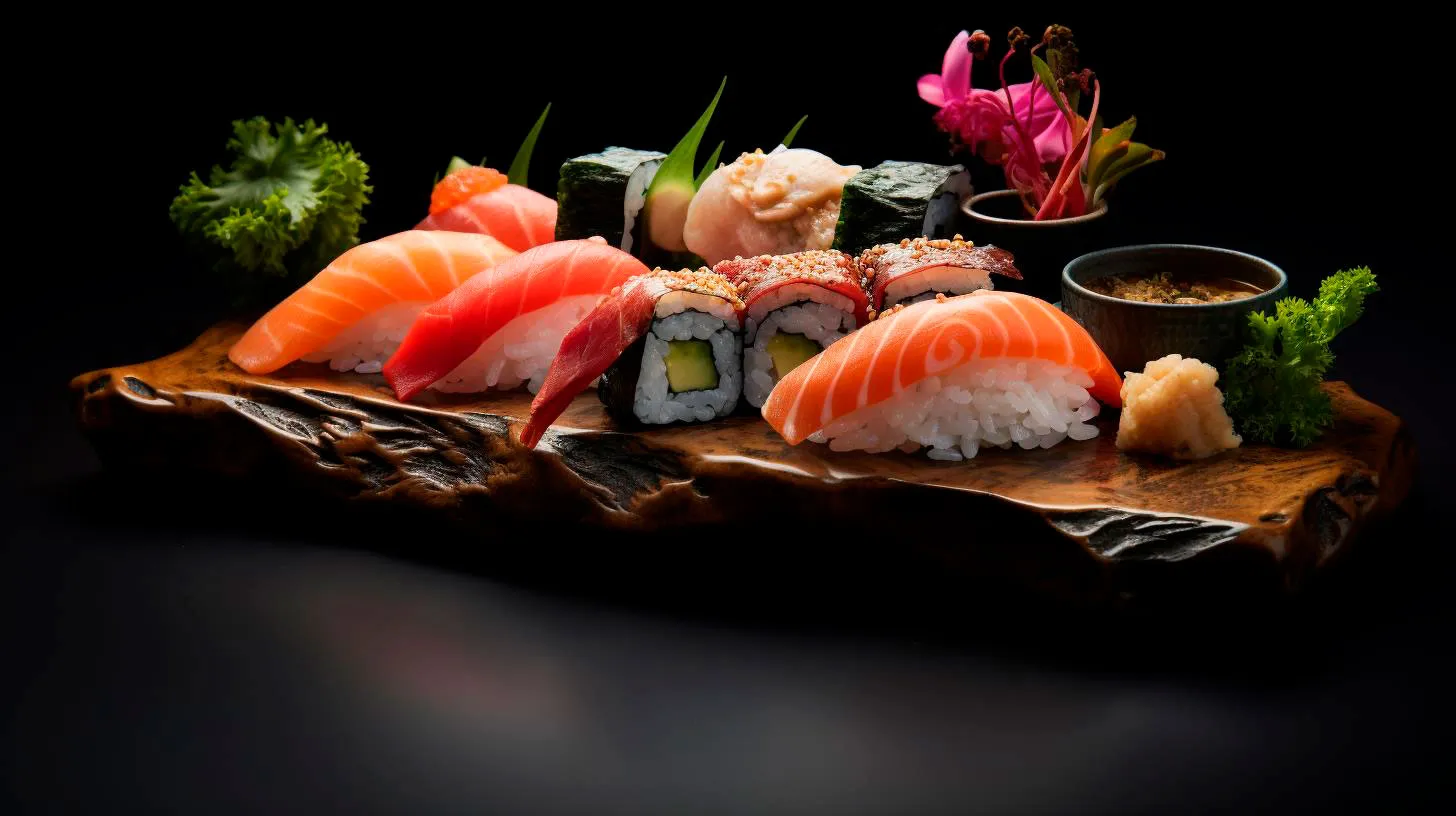Mastering the Technique of Cooking Sushi Rice to Perfection
So, grab your apron and let’s get started!
Why is Sushi Rice Preparation Important?
Before diving into the cooking process, let’s understand why sushi rice preparation is crucial for a remarkable sushi experience. The distinct taste and chewy texture of sushi rice are what make sushi rolls so satisfying. The rice serves as the foundation of any good sushi creation, enhancing the flavors of the ingredients and ensuring a delightful dining experience.
Key Takeaway: Perfectly cooked sushi rice is fundamental to creating delicious sushi rolls.
The Ideal Rice: Choosing the Right Type
The choice of rice is vital when it comes to sushi preparation. Not all rice varieties are suitable; you need a short-grain rice with a high starch content. Two popular options for sushi rice are Japanese short-grain rice and Calrose rice.
A study shows that Japanese short-grain rice, such as Koshihikari, is preferred by sushi chefs due to its stickiness and natural sweetness, making it an excellent choice for sushi rice. Calrose rice, widely available in the United States, also provides a good texture and is favored by many sushi enthusiasts.
Key Takeaway: Opt for short-grain rice varieties like Koshihikari or Calrose for the best sushi rice results.
The Rinse: Preparing the Rice
Properly washing the rice helps remove excess starch and ensures a fluffy final result. Rinse the rice under cold water until the water runs clear, ensuring you remove any impurities.
A study suggests that soaking the washed rice for approximately 30 minutes before cooking can improve its texture and make it easier to achieve the desired stickiness. Soaking gives the rice grains ample time to absorb water evenly, resulting in fluffier and chewier sushi rice.
Key Takeaway: Thoroughly rinse the rice and consider soaking it for better texture and stickiness.
The Cooking: Achieving the Perfect Texture
Now that your rice is washed and possibly soaked, it’s time to cook it to perfection. Use a rice cooker for consistent results or cook it on the stovetop.
If using a rice cooker, follow the manufacturer’s instructions. However, if cooking on the stovetop, you can follow this simple technique:
- Add the soaked rice and water to a pot in a 1:1.25 ratio (1 cup rice to 1.25 cups water).
- Bring the water to a boil over medium-high heat and immediately reduce the heat to low.
- Cover the pot and let it simmer for about 15-20 minutes, or until the water is absorbed.
- Remove the pot from the heat and let it sit, covered, for an additional 10 minutes to allow the rice to steam.
- Fluff the rice gently with a fork to separate the grains, being careful not to crush them.
Remember, cooking times may vary depending on the rice variety and your preferred texture. Experiment to find your sweet spot.
Key Takeaway: Use a rice cooker or follow a stovetop technique to cook the rice until it reaches the desired texture.
The Seasoning: Achieving the Perfect Flavor
Now that your rice is perfectly cooked, it’s time to season it with sushi vinegar. Sushi vinegar adds a tangy and slightly sweet flavor to the rice, elevating its taste in sushi rolls.
For a standard sushi vinegar mixture, combine one part rice vinegar, one part sugar, and a half part salt in a small saucepan. Gently heat the mixture over low heat, stirring until the sugar and salt dissolve.
Once the sugar and salt have dissolved, cool the vinegar mixture before folding it into the cooked rice. Use a wooden spatula to mix the rice and vinegar gently, ensuring each grain is coated evenly.
Key Takeaway: Enhance the flavor of your sushi rice by seasoning it with sushi vinegar.
The Cooling: Handling the Rice with Care
After seasoning, allow your sushi rice to cool down to room temperature before using it for sushi rolls. Avoid refrigerating the rice as it can alter its texture and affect the overall taste.
For faster cooling, spread the rice onto a large, flat surface such as a wooden sushi oke or a shallow glass dish. Use a fan or gently wave a folded newspaper over the rice to speed up the cooling process.
Key Takeaway: Cool the sushi rice to room temperature before using it in sushi rolls.
Mastering the Art of Sushi: Practice Makes Perfect
Preparing sushi rice requires practice and patience. Don’t be discouraged if your first attempts don’t yield the perfect results. With time and experience, you will develop a sense of timing and technique to consistently cook sushi rice to perfection.
Remember, sushi is not only about the rice; it’s also about the combination of high-quality ingredients and precise rolling. As you become more skilled in cooking sushi rice, you’ll embark on an exciting culinary journey, creating various sushi rolls with challenging fillings and garnishes.
So, roll up your sleeves and embark on the quest to master the technique of cooking sushi rice. Let the delicate flavors and satisfying textures of your homemade sushi rolls transport you to a culinary paradise!
Key Takeaway: Practice, patience, and experimentation are essential to perfecting the art of sushi rice preparation.
Decoding the Art of Washing and Soaking Sushi Rice
The Importance of Washing Sushi Rice
Washing sushi rice is an essential step in the sushi-making process. It not only removes any impurities or excess starch from the rice but also helps to achieve the ideal texture and consistency needed for sushi. Properly washed sushi rice ensures that each grain remains separate and doesn’t clump together, resulting in a delightful sushi experience.
Here are some key points to consider when washing sushi rice:
- Choose the right rice: Selecting the right type of rice, such as short-grain or Japanese sushi rice, is crucial for achieving the perfect texture and flavor.
- Rinse with cold water: Start by rinsing the rice under cold water to remove any dust, dirt, or impurities. Gently rub the grains together while rinsing to get rid of excess starch.
- Repeat the process: Continue rinsing until the water runs clear. This step is essential as it ensures the rice is thoroughly cleaned and free from any residual starch.
The Art of Soaking Sushi Rice
Soaking sushi rice is the next vital step in the preparation process. It helps to hydrate the rice, allowing it to achieve the desired texture and stickiness. The rice absorbs water during soaking, which enhances its flavor and ensures even cooking.
Consider these key takeaways when soaking sushi rice:
- Proper measurement of water: The ratio of water to rice is crucial for achieving the perfect texture. Generally, a 1:1 water-to-rice ratio is recommended, but it may vary depending on the type of rice used.
- Timing is essential: Soak the rice for approximately 30 minutes to allow it to absorb water fully. This helps to ensure the rice cooks evenly and achieves the desired stickiness.
- Avoid disturbing the rice: Once the rice is soaked, refrain from stirring or disturbing it. This will prevent the rice grains from breaking and losing their ideal texture.
Advantages of Properly Washed and Soaked Sushi Rice
Taking the time to master the technique of washing and soaking sushi rice yields several benefits that greatly enhance the quality of your sushi:
- Enhanced texture: Properly washed and soaked rice results in a fluffy yet sticky texture that is essential for sushi. Each grain becomes plump and tender, providing a delightful eating experience.
- Improved flavor: By rinsing and soaking the rice, you remove any unwanted flavors, impurities, or starch, allowing the natural taste of the rice to shine through. This enhances the overall flavor profile of your sushi.
- Better sushi cohesion: When sushi rice is prepared correctly, it clings together without being overly sticky. This cohesive nature allows you to shape and mold the rice easily, providing the basis for aesthetically pleasing and delicious sushi rolls.
Intriguing Sushi Rice Statistics
Lest you underestimate the significance of sushi rice preparation, consider the following statistics:
- Over 65,000 sushi restaurants operate worldwide, creating a high demand for properly prepared sushi rice.
- Japan consumes around 70% of the world’s sushi, highlighting the importance of high-quality sushi rice.
- The average sushi chef spends years perfecting their rice preparation skills to ensure an exceptional sushi experience.
In conclusion
The art of washing and soaking sushi rice is a critical aspect of creating exquisite sushi. By carefully following the techniques outlined in this article, you can achieve the perfect texture, flavor, and cohesion needed for exceptional sushi rolls. Remember, the quality of your sushi rice directly impacts the overall taste and enjoyment of this beloved delicacy. So, take the time to master the art of washing and soaking sushi rice, and watch your sushi-making skills soar to new heights!
The Perfect Blend of Vinegar and Rice in Sushi Rice
In this article, we will dive into the details of this perfect blend and explore the significance of each ingredient.
The Art of Making Sushi Rice
Sushi rice, also known as shari, is the heart and soul of any sushi dish. It is the foundation upon which all other ingredients are placed. The process of making sushi rice involves precision and care to achieve the desired texture and flavor.
The Essential Ingredients
Before delving into the details, let’s take a look at the key ingredients used in sushi rice:
- Short-grain Japanese rice: The ideal sushi rice should be slightly sticky and have a balanced moisture content. Short-grain Japanese rice, known for its stickiness and firmness, is the go-to choice for sushi rice.
- Rice vinegar: The second crucial ingredient, rice vinegar, imparts a tangy flavor to the rice and helps to prevent the growth of bacteria. It is essential for achieving the authentic taste of sushi rice.
- Sugar: A small amount of sugar is added to balance the acidity of the vinegar and enhance the overall taste of the sushi rice.
- Salt: Just a pinch of salt is added to enhance the flavors and provide a subtle salty taste to the sushi rice.
The Perfect Blend
The secret to achieving the perfect blend lies in the careful combination of these ingredients. The first step is to cook the Japanese rice to perfection. Once cooked, the rice is transferred to a wooden hangiri, traditionally a flat-bottomed wooden tub. It is while the rice is still warm that the magic happens.
A mixture of rice vinegar, sugar, and salt is gently poured over the warm rice. The rice is then meticulously folded and mixed with a wooden spatula, taking care not to mash or break the grains. This process allows the vinegar mixture to evenly coat each grain, resulting in a harmonious blend of flavors.
Once the sushi rice is perfectly mixed, it needs to be fanned to cool it down rapidly. This helps to achieve the desired texture and stickiness. The fanning process adds a final touch, giving the rice a glossy appearance and a refreshing mouthfeel.
The Significance of the Perfect Blend
The perfect blend of vinegar and rice is crucial for several reasons:
- Enhanced flavor: The careful combination of rice vinegar, sugar, and salt brings out the subtle flavors of the fish and other ingredients used in sushi. It creates a pleasant tang that complements the overall taste experience.
- Textural balance: The stickiness of the sushi rice plays a vital role in holding everything together. It allows the sushi to maintain its shape and prevents the fillings from falling out.
- Bacterial resistance: The addition of rice vinegar inhibits the growth of harmful bacteria, ensuring the safety and freshness of the sushi rice.
Key Takeaways
- The perfect blend of rice vinegar, sugar, and salt creates the unique and delightful taste of sushi rice.
- Short-grain Japanese rice is the ideal choice for sushi rice due to its stickiness and firmness.
- The process of mixing sushi rice with vinegar should be done carefully to ensure that each grain is evenly coated.
- Fanning the sushi rice after mixing helps to achieve the desired texture and stickiness.
- The perfect blend of vinegar and rice enhances the flavor profile, provides textural balance, and helps prevent bacterial growth.
Next time you savor a piece of sushi, take a moment to appreciate the exquisite combination of rice and vinegar. It is this perfect blend that elevates sushi from a mere dish to a work of culinary art.
Unlocking the Secrets of Seasoning Sushi Rice with Sugar and Salt
The art of sushi making involves a delicate balance of flavors, textures, and presentation. Central to this art is the perfectly seasoned sushi rice, known as “shari” in Japanese. Seasoning sushi rice is an age-old practice that adds a unique touch to this delectable dish. The secret behind achieving the ideal blend of acidity, sweetness, and umami lies in the careful use of two key ingredients – sugar and salt.
The Role of Sugar
Sugar acts as a significant component in the seasoning process of sushi rice, which may come as a surprise to some. However, it serves essential purposes that enhance the overall taste and texture of sushi.
Here are some key reasons why sugar is used in seasoning sushi rice:
- Balance of flavors: Adding sugar to sushi rice helps to balance out the tartness of vinegar while providing a subtle sweetness. This balance ensures that no individual flavor dominates, resulting in a harmonious taste profile.
- Texture enhancement: Sugar aids in creating a tender and slightly sticky texture in the rice. This characteristic allows the rice grains to hold together without clumping, making it easier to shape into various sushi types.
- Improving preservation: The fermentation process of sushi rice requires sugar as a food source for beneficial bacteria. This process contributes to the preservation of the rice by inhibiting the growth of harmful microorganisms.
The Role of Salt
Just like sugar, salt plays a vital role in the seasoning of sushi rice. It acts as a flavor enhancer and helps to bring out the natural flavors of the rice and other sushi ingredients.
Here are some key reasons why salt is used in seasoning sushi rice:
- Flavor enhancement: Salt intensifies the flavors of sushi rice, making it tastier and more satisfying. It enhances the umami taste, which is described as a pleasant savory flavor.
- Food safety: Salt is known for its ability to inhibit the growth of harmful bacteria, ensuring the safety of the sushi rice. This is especially crucial in preserving the rice during the fermentation process.
- Textural balance: Salt contributes to the al dente texture of sushi rice. It prevents the rice grains from becoming too soft or mushy, ensuring they maintain their desired shape and consistency.
When combined in the right proportions, sugar and salt create the perfect balance of flavors, textures, and preservation in sushi rice.
Key Takeaways
Understanding the significance of seasoning sushi rice with sugar and salt is essential for anyone looking to master the art of sushi making. Here are the key takeaways:
- Sugar balances out the tartness of vinegar, enhances texture, and aids in preservation.
- Salt intensifies flavors, ensures food safety, and maintains the desired texture.
- The right balance of sugar and salt is crucial for achieving a harmonious taste and texture in sushi rice.
Unlocking the secrets behind seasoning sushi rice with sugar and salt is a game-changer for sushi enthusiasts. By mastering this technique, you can elevate the flavors of your homemade sushi rolls or appreciate the nuances of sushi served at renowned sushi establishments.
Remember, sushi making is an art form that demands attention to detail. While genuine ingredients and expert techniques are important, never underestimate the power of perfectly seasoned sushi rice.


